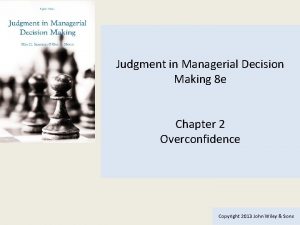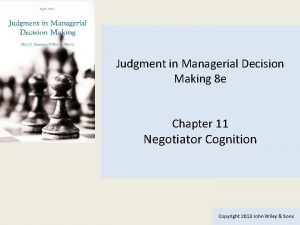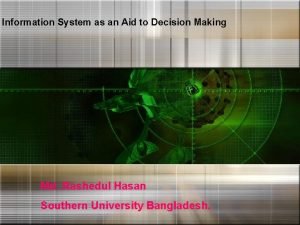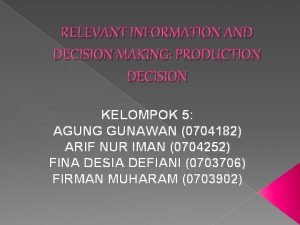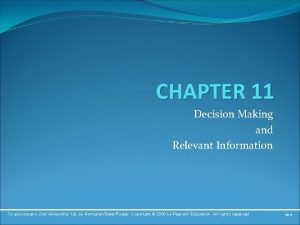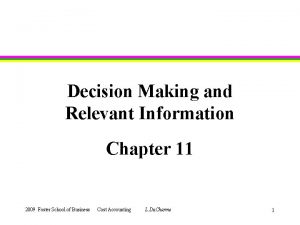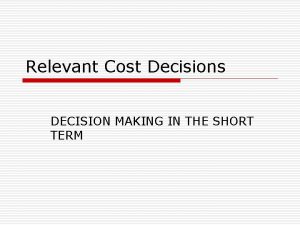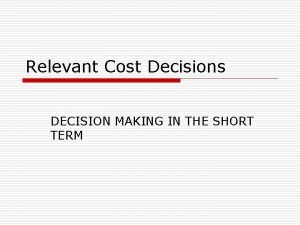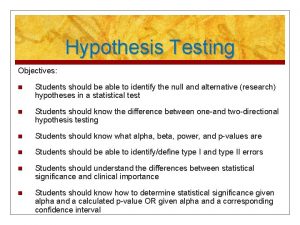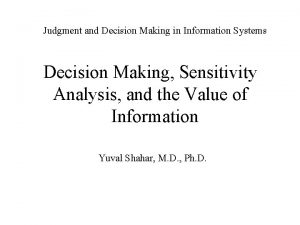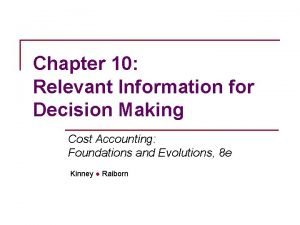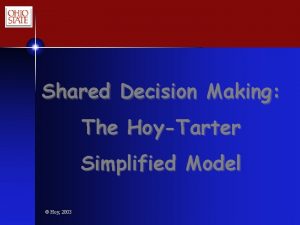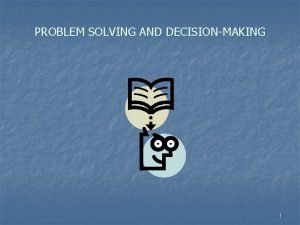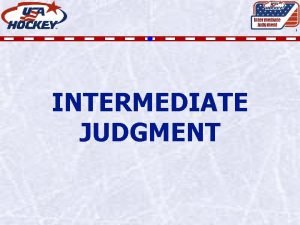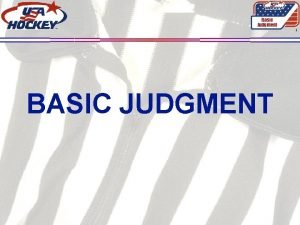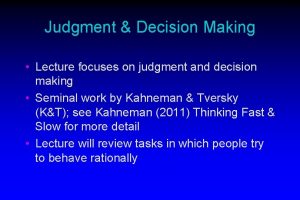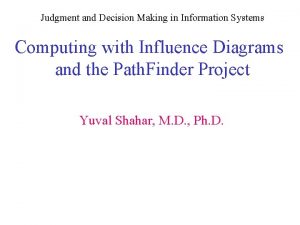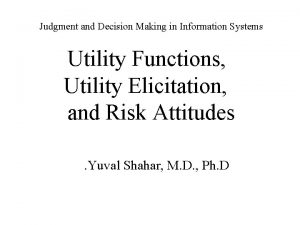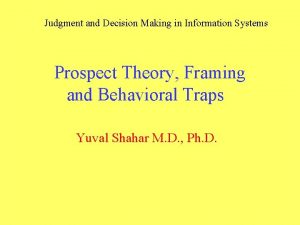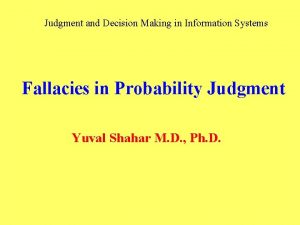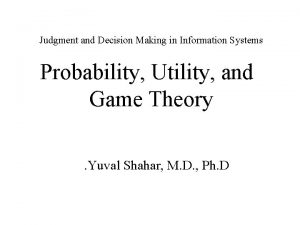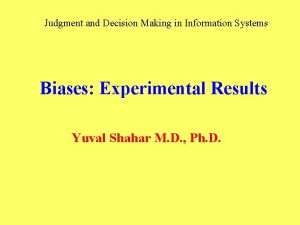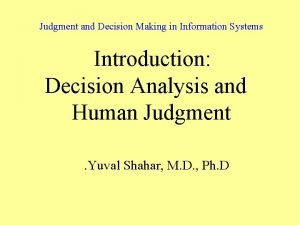Judgment and Decision Making in Information Systems Confidence

























- Slides: 25

Judgment and Decision Making in Information Systems Confidence, Forecasting, Knowledge, and Calibration Yuval Shahar M. D. , Ph. D.

Forecasting • Experts often try to forecast an event • Forecasting does not need to be absolute – it often includes a certainty measure (e. g. , 80% confidence) • Over time and multiple forecasts, it is possible to evaluate not only absolute (100%) forecasts but also probabilistic ones

Knowledge • Imagine a series of weather forecasts, with the following rain probabilities and corresponding outcomes (True, False) • Note that a probability P forecast for a “Rain” outcome is also a probability 1 -P forecast for a “No Rain” outcome; we can thus compute outcomes for both forecasts Forecast (of Rain) Result (Rainwise) 0. 2 0. 3 0. 4 0. 7 0. 9 1. 0 F F F T T

Computing Knowledge • Compute M 1: Average confidence in events that actually happened, whether positive (Rain) or negative (No Rain): – M 1 = 0. 8+0. 7+0. 6+0. 4+0. 3+0. 9+1. 0 = 0. 67 7 • Compute M 0: Average confidence in events that did not happen, whether positive (Rain) or negative (No Rain): – M 0 = 0. 2+0. 3+0. 4+0. 6+0. 7+0. 1+0. 0 = 0. 33 7 • Knowledge = K= M 1 – M 0 = 0. 34 • Note: – K=1 for perfect forecasts (M 1 = 1 and M 0 = 0) ; – K=0 when there is no difference between the confidence in events that happened or did not (M 1 = M 0 )

Calibration • Another measure of forecasting precision is comparing the confidence in the forecasted event happening to the frequency of that event • Forecasters are perfectly calibrated when their confidence is always equal to the actual frequency of the forecasted event • To draw a calibration graph we list a series of <judgment-confidence, event-frequency> points

A Calibration Graph Success Frequency 1 0. 5 0 0 0. 5 Judgment Probability 1

Perfect Evaluation Perfect calibration and perfect knowledge (K=1) Success Frequency 1 0. 5 0 0 0. 5 Judgment Probability 1

Un. Knowledgable Calibration Perfect calibration with no knowledge (K=0) Success Frequency 1 0. 5 0 0. 5 Judgment Probability 1

Partial Knowledge with Perfect Calibration Perfect calibration with partial knowledge (K=1/9) Success Frequency 1 0. 67 0. 5 0. 33 0 0 0. 33 0. 5 0. 67 Judgment Probability 1

Un. Knowledgable Over. Confidence No calibration and no knowledge (K=0) Success Frequency 1 0. 67 0. 5 0. 33 0 0 0. 33 0. 5 0. 67 Judgment Probability 1

Knowledgable Under. Confidence Partial confidence with perfect knowledge (K=1/3) Success Frequency 1 0. 67 0. 5 0. 33 0 0 0. 33 0. 5 0. 67 Judgment Probability 1

Known Calibration Examples • Meteorologists: – In 17, 514 rain judgments in Chicago over 4 years, calibration was almost perfect; mean judgment was almost the same as mean frequency, apart from a slight bias (mean difference: 3. 2%) in favor of predicting too much rain • Physicians: – Over 114 judgments of probability that a sore throat signifies bacterial infection, mean infection rate was 21. 9%, while mean judgment confidence was 44. 2%, thus a 22. 3% in favor of diagnosing bacterial infection • Note: Some of the bias might be due to focusing the physicians on only one diagnosis, and not explicitly listing other options • Lawyers: – Bias towards overconfidence in winning the case

Overconfidence in Setting Confidence Intervals for Quantities • Most people judge ranges for uncertain quantities set confidence intervals that are much too narrow (e. g. , closer to 50% than to 90% or 95%) • The reason is mostly due to anchoring to the best initial estimate, and insufficient adjustment upwards and downwards

Example of a Quantitative Estimation Overconfidence • A sample (N=24) of 4 th year and M. Sc. Information Systems Engineering students answering 10 general knowledge questions, asked for a confidence interval (range) of 90% • Instead of the desired average of 1 error person, the mean error rate was 7. 7 errors person! • For a single binary general knowledge question (“What is Absynthe? ”, the average success rate was 58%, while average confidence was 68% (N=24)

Estimation Overconfidence

Overconfidence in Positive Outcomes • People tend to overestimate the chances of positive outcomes, especially to themselves • People tend to underestimate the chances of negative outcomes, especially to themselves • Example (N=24): – When asked to estimate the chances of being addicted to a drug relative to theirs peers, students estimated their chances as being on the average 38% less likely than their peers (12 estimated them as 60+% less likely) – When asked estimate the chances of owning their apartment within 10 years relative to theirs peers, students estimated their chances as being on the average 37% more likely than their peers (16 estimated their chances as 40% to 60+% more likely)

Self-estimate of Addiction Probability Relative to Peers Mean = -38. 33% ± 26. 32% (N=24)

Self-estimate of Likelihood of Heart Attack at Age Less Than 40 Years Mean = -29. 17% ± 31. 75% (N=24)

Self-estimate of Likelihood of Owning an Apartment Within Ten Years Mean = +37. 50% ± 22. 31% (N=24)

Self Estimate of Likelihhood of Earning > 10, 000 Shekels/m Mean = +30. 83% ± 27. 31% (N=24)

Tendency to Seek Confirming Evidence • “Suppose each of the cards below (showing E, K, 4, 7) has a number on one side and a letter on the other, and someone tells you: "If a card has a vowel on one side, then it has an even number on the other side. " Which of the cards would you need to turn over in order to decide whether the person is lying ? (it can be more than one card)” • Most people choose E and 4 since it confirms the hypothesis, although turning over E and 7 is needed to disconfirm it.

Overconfidence in Case-Study Judgments (Oskamp, 1965) • Clinical psychologists accumulate casestudy material about their patients, which they might use to assess the likelihood of various diagnostic conclusions • Hypothesis: Increase in confidence in that likelihood is not necessarily correlated with an increase in diagnostic accuracy

Studying Accuracy Vs. Confidence • Three groups of subjects: – 8 experienced clinical psychologists – 18 clinical psychology graduate students – 6 advanced undergraduate students in a class in personality • Case study (Stage I): – “Joseph Kidd is a 29 year old man. He is white, unmarried, and a veteran of World War II. He is a college graduate and works as a business assistant in a floral decorating studio. ” • At each stage, subjects answered 25 5 -choice questions • Information given in four stages: – Stage II (1. 5 pp about childhood) – Stage III (2 pp about high school and college) – Stage IV (1. 3 pp about army service and activities till age 29)

Results Stage III Stage IV F P 26. 0 23. 0 28. 0 27. 8 5. 02 0. 01 Confidence 33. 2 (%) 39. 2 46. 0 52. 8 36. 06 0. 001 No. of changed answers 13. 2 11. 4 8. 1 21. 56 0. 001 Measure Accuracy (%) --

Summary • Accuracy was close to random, was similar for all three subject groups, and did not significantly increase with information • Confidence levels, however, increased significantly from 33% in Stage I to 53% in Stage IV as more information was provided • As more information was given, the number of changed answers declined significantly, suggesting that judges formed opinions early and were reluctant to change them in the light of new information • Thus: Personal feelings of increasing confidence in a conclusion are a very poor sign of its validity!
 Judgement in managerial decision making
Judgement in managerial decision making Mythical fixed pie assumption
Mythical fixed pie assumption How do information systems aid in decision making
How do information systems aid in decision making No decision snap decision responsible decision
No decision snap decision responsible decision Slidetodoc.com
Slidetodoc.com Chapter 2 economic systems and decision making answer key
Chapter 2 economic systems and decision making answer key Chapter 2 economic systems and decision making
Chapter 2 economic systems and decision making Chapter 2 economic systems and decision making answer key
Chapter 2 economic systems and decision making answer key Decision making and relevant information
Decision making and relevant information Five step decision making process
Five step decision making process Relevant information for decision making
Relevant information for decision making Chapter 11 decision making and relevant information
Chapter 11 decision making and relevant information Decision making and relevant information
Decision making and relevant information Decision making and relevant information
Decision making and relevant information Decision making and relevant information
Decision making and relevant information Confidence interval vs confidence level
Confidence interval vs confidence level Confidence interval z value
Confidence interval z value Decision support systems and intelligent systems
Decision support systems and intelligent systems Value of information in decision making
Value of information in decision making Relevant information for decision making
Relevant information for decision making Decision tree and decision table examples
Decision tree and decision table examples Using recursion in models and decision making
Using recursion in models and decision making Using functions in models and decision making
Using functions in models and decision making Chapter 6 prices and decision making assessment answers
Chapter 6 prices and decision making assessment answers Hoy-tarter model of shared decision making
Hoy-tarter model of shared decision making Best books on problem solving and decision making
Best books on problem solving and decision making
